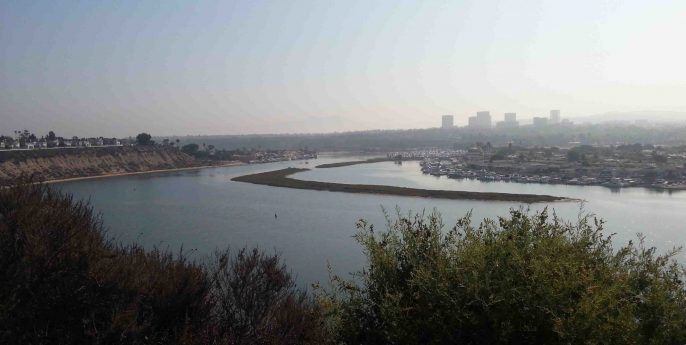Newport Bay study to examine scientific basis for shellfish water-quality standard

The study, which is about two years in the making, will examine whether California’s existing standard for permissible bacterial levels in the water correlates to potentially unsafe levels of pathogens in bivalve shellfish harvested from Newport Bay. Bivalve shellfish such as mussels and oysters are filter feeders that can take up bacteria and viruses from the water column, potentially concentrating them in their tissues.
Researchers and water-quality managers developed the study in response to a looming bacterial TMDL (total maximum daily load) regulatory deadline in Newport Bay that mandates compliance with the statewide recreational shellfish water-quality standard by 2022. The standard is commonly abbreviated SHEL.
Newport Bay, which is failing the standard year-round, is the first water body in California that faces a TMDL deadline related to the SHEL standard.
The Santa Ana Regional Water Quality Control Board is among the regulatory agencies that have questioned whether the standard – set nearly a century ago and not validated using local shellfish data – is supported by a sufficient technical foundation.
The SHEL standard caps monthly median fecal coliform counts in the water column – a proxy for potential pathogenic contamination – at 14 per 100 mL. This standard is far more difficult to meet than California’s REC-1 standard designed to protect the health of swimmers. The REC-1 standard caps monthly median fecal coliform counts at 200 per 100 mL, among other measures.
Newport Bay water-quality managers are largely in compliance with REC-1 water-quality standards during the popular summer beachgoing months, although they struggle with compliance during wet weather.
The Newport Bay shellfish study will kick off in late spring with a pilot study that involves deploying Pacific oysters in cages at multiple sites around the bay over a six-week period. The oysters will be harvested at different time points, and researchers will measure viral pathogens and fecal bacterial indicators in their tissues to assess accumulation rates. Water samples also will be collected to determine if a relationship exists between contamination in the water column and in the oysters.
The results of the six-week pilot study will inform if and how researchers move forward with an expanded study spanning the wet-weather and post-wet seasons.
If the water-column bacterial indicator measurements are found to positively correlate with pathogen levels found in the shellfish, researchers would conclude that California’s existing SHEL standard is working as designed, likely rendering the larger study unnecessary.
If, however, there is no relationship between the water-quality indicators and pathogens found in the shellfish, the study could provide a scientific basis for pursuing development of a site-specific SHEL standard for Newport Bay, and/or a follow-up study examining the appropriateness of using a fecal coliform-based standard in California to protect shellfish.
For more information, contact Dr. John Griffith.
More news related to: Microbial Risk Assessment, Microbial Water Quality, Top News